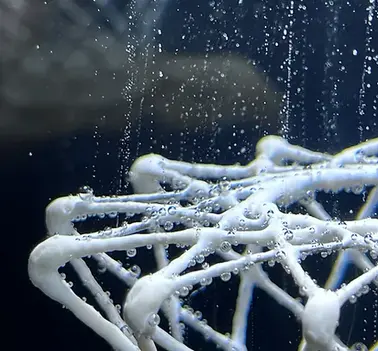
MINERAL ACCRETION
Breathing Life
How does a metal structure become a living reef?
Marine organisms will grow on almost anything, including metal. Without protection exposed metal surfaces will start to rust after time, which depletes environmental oxygen and isn’t good for an ecosystem. By sending a small electric charge through ocean water, dissolved minerals available in the seawater accrete onto the surface of a charged structure. This protects the metal from corrosion and increases both the settleable surface area on the structure and it’s structural stability.
Close-up look at the electrolysis and accretion processes occurring around a scale prototype SeaWeaver structure

Encased In Reef
The material that accretes from ocean water onto the reef is Calcium Carbonate: the same material as hard coral build their skeletons out of. Natural reef formations are the accumulation of many layers of encrusted coral skeletons, so the electrolysis process gives the accreted surfaces of SeaWeaver structures an identical composition to natural reefs that corals and kelps seek to recruit onto in the wild.
The surfaces of SeaWeaver prototypes after undergoing electrolysis in ocean water
Mineral Accretion In The Ocean
The electric current used in electrolysis poses no danger to wildlife; it’s so low that is can’t be perceived even when directly touching the metal surface. As soon as a calcium carbonate layer begins to appear, marine micro-organisms eagerly cover the familiar substrate in a fuzzy bio-mat (which does not inhibit continued accretion).
Original building material (9mm construction rebar) next to 11 months of accretion growth









